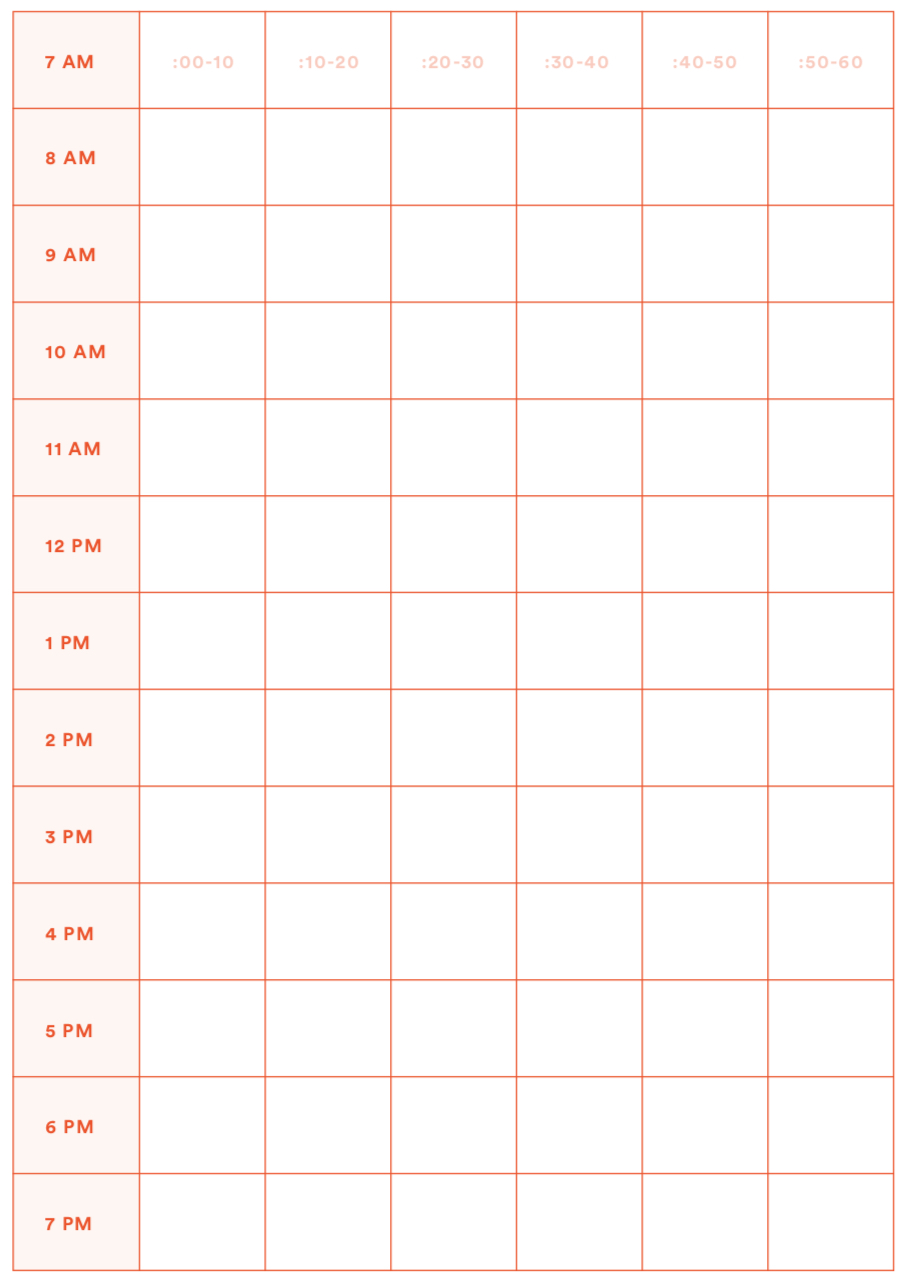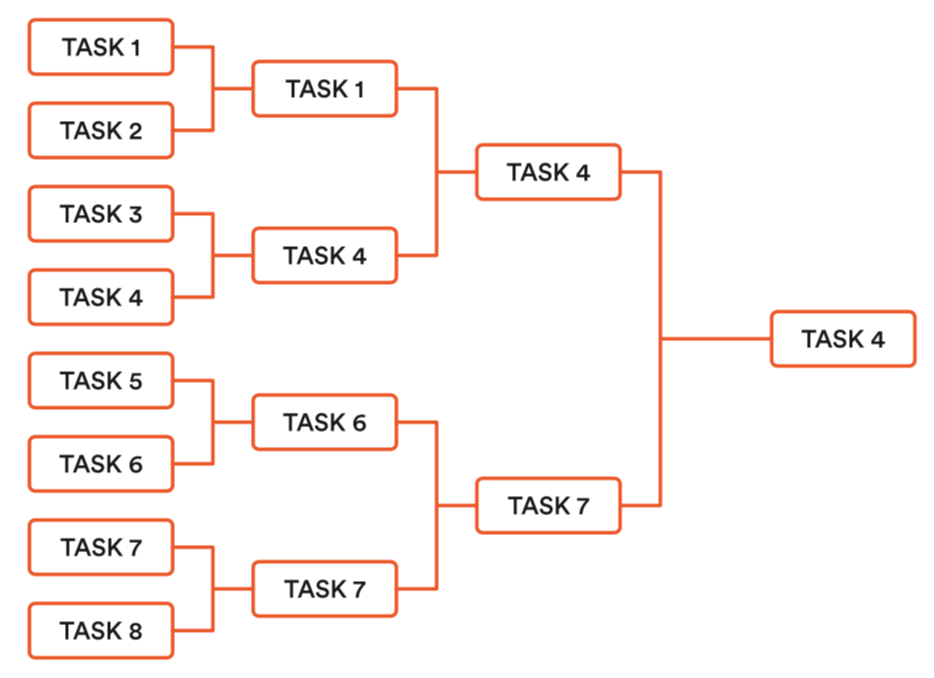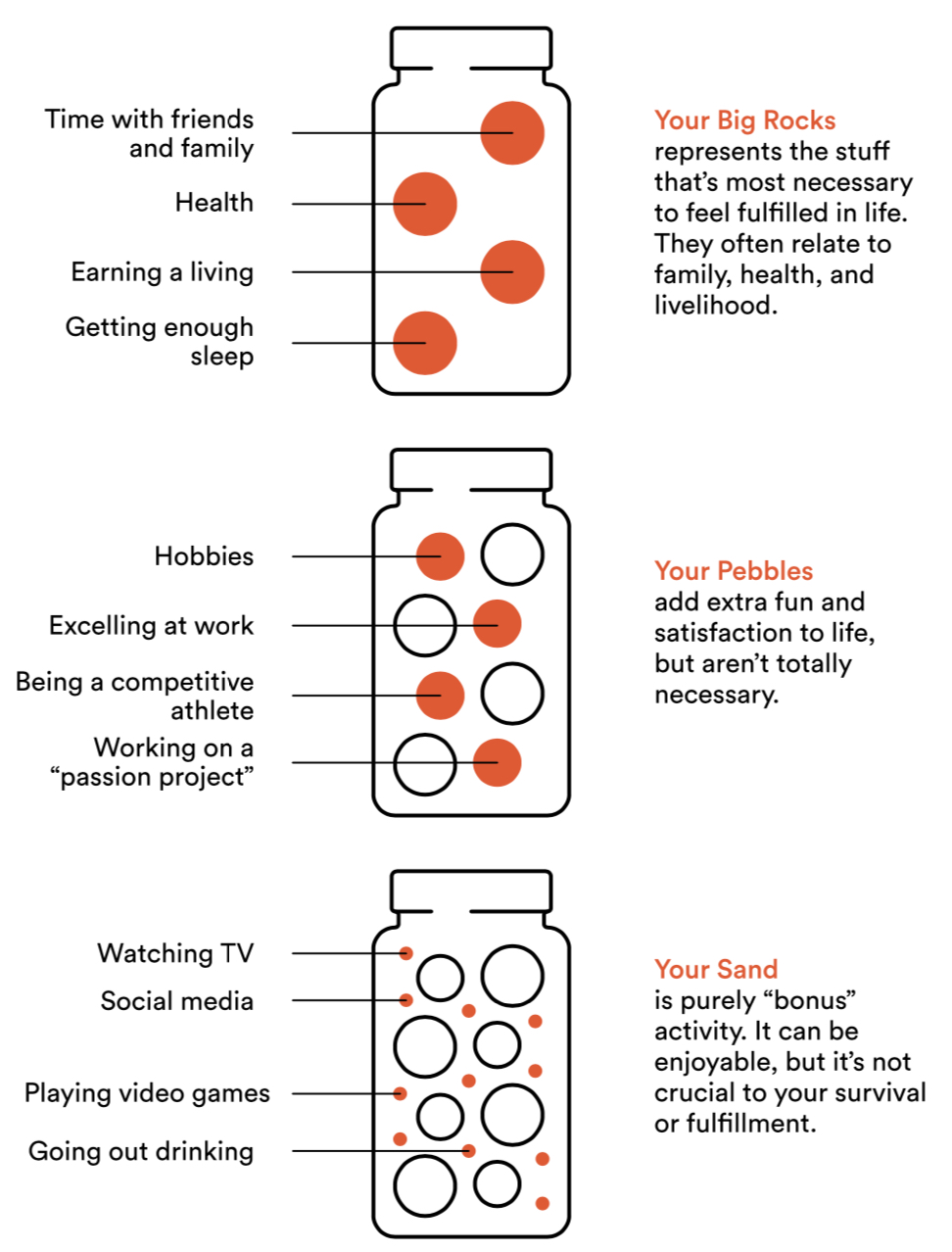The Tournament Technique: Here’s How To Prioritize What Really Matters In Your Health And Fitness Business
++
When it comes to building a great career in health and fitness, your first priority is to learn how to prioritize. Because, among the seemingly million things you feel like you “should” be doing, only a few really matter. Here are 4 strategies for figuring out what they are including my favorite, The Tournament Technique.
++
The Apple Meeting That Changed My Mind
Early in my career, I dreamed of a day when I had access to more resources. More time, more money, more talented people to help out. With more of these resources, I reasoned, I wouldn’t have to prioritize so ruthlessly. I could do everything that felt important.
Cue world domination music.
Then I started consulting with companies like Apple, Equinox, and Nike. After one particular board meeting, in which an Apple executive talked about his big frustrations with resource constraints, a new idea hit me.
If executives at the biggest companies in the world are still complaining about resource constraints, they must never go away!
Think about it: Apple is consistently ranked one of the top three wealthiest companies in the world. So, if they never have enough resources, well, no company will have enough resources. Ever.
This was an epiphany. A breakthrough.
I realized that, instead of constantly worrying about resource constraints, instead of griping about how good everyone else with more resources must have it, my big opportunity was to work on my attitude.
I decided that, if I wanted to do great work, if I wanted to enjoy my career, I’d have to get really good at prioritization as a way to use whatever resources I had more effectively. By doing this, I reasoned, the griping and worrying could be replaced by a calm feeling of confidence and efficacy.
Effectiveness vs. Efficiency
The lesson I shared above applies whether you’re the co-founder of a company, an executive at that company, an employee of that executive, or even an independent contractor.
We all have never-ending lists of things we could do. Facing these long lists can feel frustrating and demoralizing if there’s no criteria for figuring out what’s important to do next.
Some folks try to handle this problem by thinking in terms of efficiency. They look for ways to get more done in less time. Time-saving tricks. Productivity hacks. Radical efficiency.
However, even if you’re busy knocking off to-dos at an alarming pace, you won’t be accomplishing anything important if those to-dos aren’t worth doing.
All your time, energy, talent, and unique abilities will be wasted.
Of course, efficiency is important. But if I had to prioritize between efficiency and effectiveness—doing the right things—I’d pick effectiveness every time.
The Prioritization Juggling Act
Prioritizing effectiveness means getting clear on what’s worth doing (and what’s not worth doing) and then focusing on that almost exclusively.
Later in this article I’ll share how I do it.
For now, here’s a hint: Don’t ask what you can accomplish in a week, ask what you can accomplish in a year.
I was recently asked, “In the early days of Precision Nutrition, what did you focus on? Was it content? Did you have help with that? How involved were you on the business side? Or did you hire help there? How about the coaching side?”
In essence, “While you were small and didn’t quite have the resources yet, how did you deal with everything?”
Those, of course, are prioritization questions.
When we started the company it was just Phil Caravaggio (PN’s co-founder) and me. We did everything, so we had to make hard choices, every week.
Each Monday we’d start by identifying the most important thing to accomplish that week, defined by its ability to help us grow the business. We’d be ruthless about keeping to that, even if something new, exciting, or distracting came up.
As a result, some weeks were all about working on content. Others marketing. Others finance. Others shipping and logistics.
It was a constant balancing act using the theory of constraints as our guide, a process by which you identify the most important limiting factor standing in the way of your goals and then improve that thing until it’s no longer the bottleneck or weak link in the chain.
The Anxiety of Prioritization
Using this methodology, the weekly priorities often changed. But what remained constant was this: We always had one task sitting on the throne of the Kingdom of To Do.
Even more, everything that didn’t make the To Do list became our de facto To Not Do list. Often that list contained great ideas. But, sometimes frustratingly, they’d have to wait.
This practice takes discipline because it’s easy to feel anxious and impatient within any given week. Indeed, many weeks I was riddled with anxiety thinking I’ll never make a dent in my big goals at this pace!
However, experience taught me I can accomplish a helluva lot over the course of a year if my activity is well-prioritized and I stay focused on the right work.
(And counseling taught me how to deal with the impatience, stress, and anxiety I’d often feel before I learned that lesson).
The Benefits Of Prioritization Add Up Over Time
With all that said, I don’t want to imply that we were excellent at prioritization from the start. Neither Phil nor I had any formal business training or any reps at figuring out how to prioritize.
We weren’t perfect. Yet we continued to try our best. Considering that some weeks we got it wrong, and others we did nothing worthwhile at all, we still accomplished a lot in a year.
Over the first 5 years we achieved massive goals that we’d have never dared to set in the early days. Now, 13 years into it, the results of our commitment to prioritization are obvious.
Sure, if you’re in the depths of time or resource scarcity, it can feel like no matter how much you want to power through responsibilities, there are always 10,000 other things to do. And they all have to be done.
That’s when you most need to work on your prioritization skills. Develop them, using the following strategies, and you’ll feel less anxiety. Even better, you’ll figure out how to do the right work in the most effective ways.
Strategy #1:
Re-frame your definition of productivity.
In many work cultures, there are implicit social rewards for being busy and for doing more than the next person. But working ninety hours a week and feeling like your brain is in a high-speed blender isn’t actually rewarded unless those hours lead to the achievement of big, important goals.
What if we can achieve those big, important goals without the brain blender? What if we do much less than everyone else but make sure everything we do is of critical importance and moves the needle in measurable, meaningful ways? By prioritizing effectiveness over efficiency, can we stand out from our peers and accomplish more?
Turns out the answer is yes. In fact, most of the extremely high performers I know take a similar approach.
PRODUCTIVITY IS NOT
- sleeping less, working more, and hustling harder
- multitasking social media on your phone while doing invoices and responding to emails on your desktop
- “productivity hacks” that are supposed to make you more efficient but scramble your thinking instead
- trying to do everything that could make a difference because you’re afraid of missing out
PRODUCTIVITY IS
- organizing and prioritizing your time ruthlessly
- ditching many low-leverage tasks and replacing them with a few high-leverage tasks
- automating the things that can be automated
- focusing the rest of your time on your unique abilities
None of this, of course, means that developing your skills and your business is going to be easier or less work. When you’re just starting out, there is no “four-hour work week.”
However, prioritizing effectiveness helps you make sure all the hard work you’re inevitably going to do is spent doing the right things, not the things that make you busy with no payoff.
Strategy #2:
Free up time for more high-leverage work.
In health and fitness we often ask clients to fill out food diaries and training logs. The professional equivalent? A time and activity log. The idea is to keep a record of everything you do during your week, cataloging your tasks and the time it takes to do them.
We ask our students to do this every year and they’re always surprised to see how they’re really spending time vs. how they think they’re spending it.
For example, some find they’re on social media or browsing the internet or watching TV more than expected. Others realize they might even be—gasp—exercising more than needed.
You don’t need fancy apps or time trackers for this, although you can use them if you want. Your log could be as simple as keeping a Time Diary.

After a week or so of recording, divide your work into one of these categories:
- Low-leverage activities I worked on
- High-leverage activities I worked on.
- High-leverage activities I didn’t work on*.
*These are the activities you know are important and will produce a high return but you simply didn’t make time for.
Next, look at how much time you’re spending on low-leverage activities, the ones that feel urgent or important but don’t make a difference in getting clients, keeping them, growing a business, or achieving any goal you’ve set out to achieve.
Back when I was a full-time personal trainer and lifestyle coach, it was scheduling, invoicing, and answering basic questions about protein and peanut butter that felt annoying, low leverage, and in the way of my bigger goals. If I was busy doing these things, I wasn’t working on getting new clients, building systems, or learning more about my craft.
Next ask yourself if there’s a way to cut down on the time you’re spending on low-leverage things by creating templates for the same emails you send out every week, or using scheduling software, or using an automated billing system.
Are there some you can flat-out eliminate? Is there a way to structure your month so certain tasks can be done in a single chunk on a specific day, rather than having them hang over your head every day or every week?
The goal here isn’t necessarily to eliminate low-leverage activities. Some of them are necessary, for now anyway. Rather, the goal is to reduce time spent on them, freeing you up to do more high-leverage stuff, including some of the tasks you’ve been procrastinating for much too long now.
Strategy #3:
Schedule time to think.
If you’ve followed steps #1 and #2 above you’ll have bought back some time. Maybe a little, maybe a lot. So what should you do with that time?
If you’ve been overstressed and overworked for much too long, rest. Seriously. Take a nap, go to the spa, spend time in nature. Invest in recharging your physical and mental batteries because you’ll need to be at the top of your game for what comes next.
What does come next? Booking appointments with yourself for thinking about, researching, sanity-checking, and getting others’ thoughts on the high leverage work worth tackling now. This is so important that I’d like you to schedule that time right now.
- Which day of the week can you budget a few hours for thinking?
- How long can you budget for this?
Now pop open your calendar and make your first appointment with yourself to do it. Seriously, pick a day.
Look, I get it. When there’s so much to do it can seem like a waste of time to spend a few hours per week thinking. Yet, once you reorient your mind to effectiveness over efficiency, you’ll see this is your best opportunity to figure out how not to get into the same position again.
You’ll start considering how to eliminate or automate lower-leverage activities. Plus you’ll begin to discover the high-leverage activities that can remove your biggest limiting factors and get you to your goals.
I spend a half day on this every week. In my calendar, “Thinking” is blocked off from 9am until 1pm every Friday. Of course, during this time I don’t just sit in lotus pose and hope ideas start ziplining from neuron to neuron.
I use the time for brainstorming, journaling, mind mapping, interviewing experts, reading, and more. All to help solve current problems or to think up my next set of high-leverage opportunities.
Strategy #4:
Play the to-do tournament to decide what’s next.
After a while, if you do all this right, you’ll likely end up with a too-long list of interesting and high-leverage to-dos. This is a great problem to have yet it can still turn into an imposing wall of items and deadlines, a grocery list of responsibilities where it doesn’t matter which aisle you go down first.
However, to-do lists shouldn’t operate like grocery lists with each item being treated equally. They should operate more like bracketed sports tournaments where items have to compete for the main prize, your precious time and energy.

For smaller tasks, daily or weekly tournaments can help you decide what to do for the next few hours, or for the next few days.
For larger strategic goals, quarterly or annual tournaments can help make it clear what you should be working on for the entire year, plus help make sure your daily and weekly tournaments are being decided based on your larger goals.
And, if it helps, think of your time as a jar, which you can fill with a finite number of rocks, pebbles, and sand.
Here’s an example:

No matter the time scale, if you want to increase your probability of success without committing to working twice as many hours as everyone else—which isn’t a guarantee of success either—you need ruthless clarity and prioritization.
As time goes by, more and more opportunities will come flying at you. You’ll never have enough resources. Your only competitive advantage, therefore, is a counterintuitive one: Put rigid constraints on your time, figure out the very few opportunities worth doing, focus on those few unwaveringly, and pass on everything else.
Key Takeaways
When it comes to ruthless prioritization, follow these four steps:
Free up time for more high leverage work.
Track all of your activities for a week and get really clear on how you’re spending your time. You might be surprised. Find ways to reduce the time you spend on low-leverage activities to free yourself up for more high-leverage tasks.
Schedule time to think.
Book appointments with yourself to think, research, and solicit thoughts on your high-leverage opportunities. Here are some questions you can use to evaluate your ideas.
Play the to-do tournament to decide what’s next.
Once you have a great list of high-leverage activities, set them against one-another and have them compete for your precious time and energy.
Reframe your definition of productivity.
Working endlessly isn’t the goal. Nor is “getting a lot done”. The goal is to get the right things done. Then to rest up. This way you can remain clear-headed enough to figure out the next right thing to do.
Want to learn more?
Then check out Dr John Berardi’s one-of-a-kind book – winner of the 2021 Axiom Business Book of the Year – Change Maker: Turn Your Passion For Health and Fitness into a Powerful Purpose and a Wildly Successful Career.
The health and fitness industry is huge, highly competitive, and often confusing to navigate. Dr. Berardi helps you make sense of the chaos, laying out a clear roadmap to help you achieve both personal and professional success.
